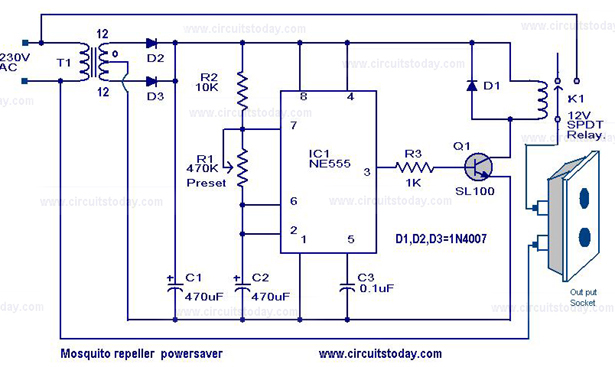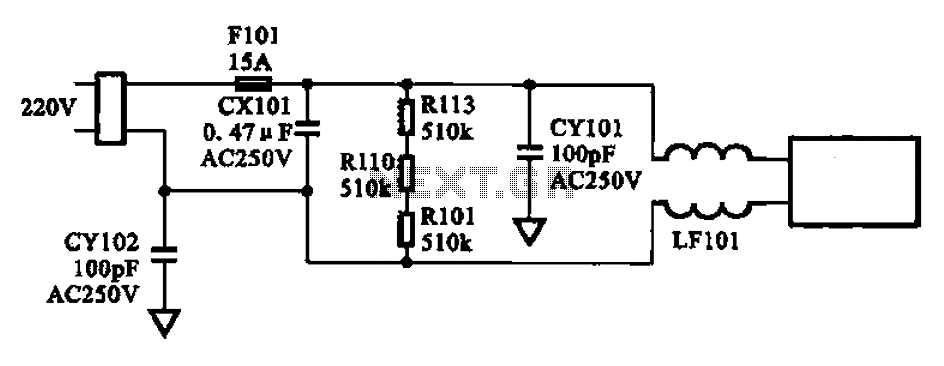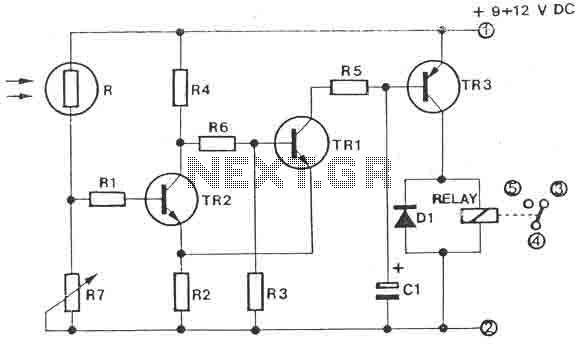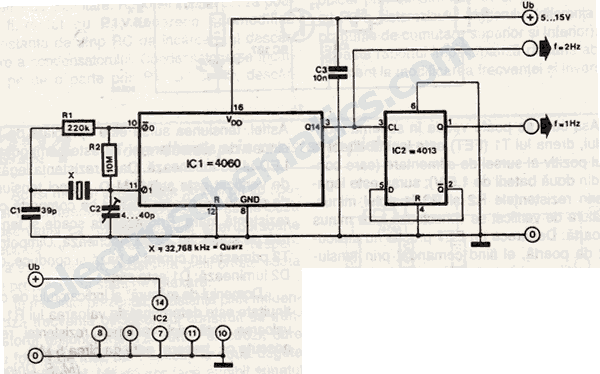
Mosquito repeller power saver circuit and energy saver circuit diagram

The circuit diagram of a mosquito repellent power saver circuit is provided along with a detailed explanation.
The mosquito repellent power saver circuit is designed to efficiently operate a mosquito repellent device while minimizing energy consumption. This circuit typically integrates a microcontroller or a timer IC, which controls the activation and deactivation of the repellent device based on predefined intervals.
The schematic may include essential components such as resistors, capacitors, and transistors, which help in regulating the power supply and ensuring that the device operates within safe limits. A common configuration might involve a 555 timer IC, which can be set up in astable mode to generate a square wave output. This output can be used to drive a transistor that acts as a switch, turning the repellent device on and off at specified intervals.
Power supply considerations are crucial; the circuit may require a regulated DC source, often derived from an AC mains supply through a transformer and rectifier setup. Additionally, the use of a capacitor for smoothing the rectified voltage is typical to ensure stable operation.
For enhanced efficiency, the circuit design may incorporate features such as a low-power mode, where the microcontroller or timer IC consumes minimal energy during inactive periods. This approach not only prolongs the life of the power source but also reduces overall energy costs associated with the operation of the mosquito repellent device.
The layout of the circuit should be carefully designed to minimize interference and optimize the performance of the components. Proper placement of the components and routing of the connections are essential to ensure reliable operation and to prevent issues such as noise or voltage drops that could affect the functioning of the circuit.
Overall, this mosquito repellent power saver circuit serves as an effective solution for maintaining pest control while being energy efficient, making it suitable for both residential and commercial applications.The circuit diagram of a mosquito repellent power saver circuit is given with a detailed explanation.. 🔗 External reference
The mosquito repellent power saver circuit is designed to efficiently operate a mosquito repellent device while minimizing energy consumption. This circuit typically integrates a microcontroller or a timer IC, which controls the activation and deactivation of the repellent device based on predefined intervals.
The schematic may include essential components such as resistors, capacitors, and transistors, which help in regulating the power supply and ensuring that the device operates within safe limits. A common configuration might involve a 555 timer IC, which can be set up in astable mode to generate a square wave output. This output can be used to drive a transistor that acts as a switch, turning the repellent device on and off at specified intervals.
Power supply considerations are crucial; the circuit may require a regulated DC source, often derived from an AC mains supply through a transformer and rectifier setup. Additionally, the use of a capacitor for smoothing the rectified voltage is typical to ensure stable operation.
For enhanced efficiency, the circuit design may incorporate features such as a low-power mode, where the microcontroller or timer IC consumes minimal energy during inactive periods. This approach not only prolongs the life of the power source but also reduces overall energy costs associated with the operation of the mosquito repellent device.
The layout of the circuit should be carefully designed to minimize interference and optimize the performance of the components. Proper placement of the components and routing of the connections are essential to ensure reliable operation and to prevent issues such as noise or voltage drops that could affect the functioning of the circuit.
Overall, this mosquito repellent power saver circuit serves as an effective solution for maintaining pest control while being energy efficient, making it suitable for both residential and commercial applications.The circuit diagram of a mosquito repellent power saver circuit is given with a detailed explanation.. 🔗 External reference





